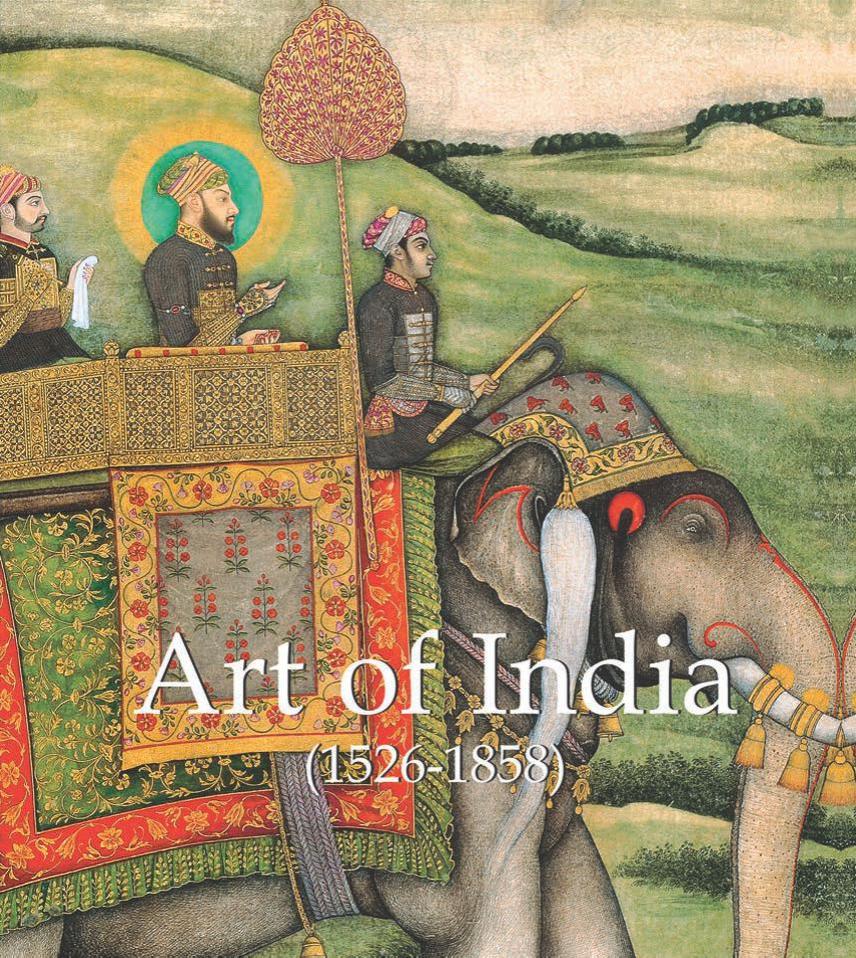Art of India by Smith Vincent Arthur

Author:Smith, Vincent Arthur. [Smith, Vincent A.]
Language: eng
Format: epub, pdf
ISBN: 9781783107834
Publisher: Parkstone International
Published: 2015-05-28T04:00:00+00:00
A comic scene of two gnomes at play, the first half of the 6th century C.E. Detail of ceiling panel. Ajanta caves (Cave I), near Aurangabad, Maharashtra.
‘The Indian practice of wall-painting at Ajanta, as elsewhere’, Mr. Griffiths observes, ‘is in fact a combination of tempera with fresco. The hydraulic nature of Indian lime, or chunam, makes it possible to keep a surface moist for a longer time than in Europe, and the Indian practice of trowelling the work unknown in Europe produced a closer and more intimate liaison between the colour and the lime, and a more durable and damp-resisting face than the open texture of European fresco. The art has been practised all over India since the time of the Ajanta frescoes, and to this day houses, mosques, and temples are thus decorated. The modern method is first to spread a ground of coarse mortar (chunani) of the thickness of from one to two and a half centimetres on the Avail. This is allowed to stand for a day. If on the next day the ground is too dry, it is moistened, and then tapped all over with the edge of a small piece of wood of triangular section, to roughen it and give it a tooth. Then, with a coarse brush a thin coating of fine white plaster (chunam) is applied, and the work is allowed to stand till the next day, being moistened all the time. If the painting is to be highly finished, the ground is carefully smoothed with a small flat iron trowel about the size of a dessert spoon, which produces a surface on which the design is first sketched, or transferred by pouncing from a perforated drawing on paper, and then painted.
The outline is usually put in first in brown or black; local colour is filled in with flat washes, on which the details are painted.
The colours are ground with rice or linseed-water with a little coarse molasses (gur), and water only is used in painting. Then, when the painting is completed, it is again rubbed over with the same small trowel. It is considered absolutely necessary that the work should be kept damp from beginning to finish, so that the plaster is not allowed to set until the completion of the picture. When once the smoothly trowelled surface is dry, it bears a distinct sheen or gloss and the colours withstand washing.
Between the methods of modern India and that employed at Ajanta, the only difference is that instead of a first coat of mortar, a mixture of clay, cow dung, and pulverized trap rock was first applied to the walls and thoroughly pressed into its sic surface, when the small cavities and air-holes peculiar to volcanic rock and the rough chisel marks left by the excavators served as keys. In some instances, especially in the ceilings, rice husks were used.
This first layer which, according to our modern notions, promises no great permanence was laid to a thickness varying from a one-fourth to two centimetres, and on it an egg-shell coat of fine white plaster was spread.
Download
This site does not store any files on its server. We only index and link to content provided by other sites. Please contact the content providers to delete copyright contents if any and email us, we'll remove relevant links or contents immediately.
| Africa | Americas |
| Arctic & Antarctica | Asia |
| Australia & Oceania | Europe |
| Middle East | Russia |
| United States | World |
| Ancient Civilizations | Military |
| Historical Study & Educational Resources |
The Sympathizer by Viet Thanh Nguyen(4276)
The Rape of Nanking by Iris Chang(4115)
World without end by Ken Follett(3406)
Ants Among Elephants by Sujatha Gidla(3376)
Blood and Sand by Alex Von Tunzelmann(3112)
Japanese Design by Patricia J. Graham(3087)
City of Djinns: a year in Delhi by William Dalrymple(2493)
The Queen of Nothing by Holly Black(2451)
Foreign Devils on the Silk Road: The Search for the Lost Treasures of Central Asia by Peter Hopkirk(2414)
Inglorious Empire by Shashi Tharoor(2381)
India's Ancient Past by R.S. Sharma(2376)
Tokyo by Rob Goss(2352)
In Order to Live: A North Korean Girl's Journey to Freedom by Yeonmi Park(2323)
Tokyo Geek's Guide: Manga, Anime, Gaming, Cosplay, Toys, Idols & More - The Ultimate Guide to Japan's Otaku Culture by Simone Gianni(2299)
India's biggest cover-up by Dhar Anuj(2289)
The Great Game: On Secret Service in High Asia by Peter Hopkirk(2268)
Goodbye Madame Butterfly(2184)
Batik by Rudolf Smend(2069)
Living Silence in Burma by Christina Fink(2019)
